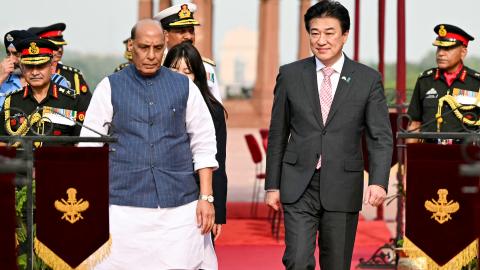In August 2024, India and Japan held a 2+2 foreign and defense ministers’ meeting in Delhi. The main topic was security and defense issues. Although this was merely the third 2+2 after one that took place in September 2022, there are three reasons why this latest meeting was a historical development.
Japan’s Participation in Tarang Shakti
First and most importantly, just before the 2+2 meeting, Japan publicized the first air visit by Japanese fighter jets and their participation at Tarang Shakti, the first multilateral exercise hosted by the Indian Air Force. At the 2+2 meeting, India-Japan expressed approval of the meeting’s joint statement. The Tarang Shakti exercise is India’s newest step toward cooperation with other members of the Quadrilateral Security Dialogue, or Quad.
For a long time, India has hesitated to emphasize the military aspect of the Quad. One of the reasons is related to the India-China land border. If China believed that the Quad is a military alliance aimed against it rather than just a diplomatic partnership, China would make all efforts to see it disbanded.
In such a scenario, there is a strong possibility that India could be China’s first target. India is the only Quad member that has a land border with China. Because of this, China is relatively well-placed to exert military pressure on India. Also, India is the only Quad member that is not a formal military ally of the U.S. and therefore, China believes that India can distance itself from the U.S. because there are no legal bindings. In addition, China is confident of having an upper hand because it won the battle against India in 1962. Therefore, to avoid provoking China,, the Quad should be focused mainly on maritime cooperation and not land border issues. As a result, India held military exercises that all Quad members joined, including naval exercises such as Malabar and Miran.
However, China has not respected India’s restraint. China’s incursions on the India-China border has increased from 213 incidents in 2011 to 663 in 2019. In 2020, a large contingent of Chinese troops entered the Indian side and clashed with Indian troops. As the Chinese troops were well-prepared and well-armed (iron rods studded with nails, etc), 20 Indian soldiers were killed and 76 Indian soldiers were injured, along with an unknown number of Chinese soldiers (the Chinese government’s official number of deaths was only 4, but that is not believable). Since 2020, many Chinese troops with high-tech weapons, including hypersonic missiles and stealth fighter jets, have been deployed on the India-China border and have continued to raise tensions. As a result, the scope of India’s military exercises have changed.
In 2022, India-U.S. held joint exercises of land forces within 100 km from the India-China land border. In 2023, a US Air Force B-1 bomber was deployed for the first time to Kalaikunda Air Base, which was used by the U.S. to bomb Japanese imperial forces in China during WWII. The B-1 bomber is a platform for Tomahawk cruise missiles with conventional warheads, and it is effective in destroying tunnels and bridges. Since the India-China border is in mountainous terrain, Chinese ground forces rely on a number of tunnels and bridges. In addition, this exercise brought in Japanese observers. Step by step, India has started to expand the Quad’s joint military exercises from naval-based to air- and land-based to retaliate against China’s provocations. The latest iteration is Tarang Shakti.
Cooperation in Ship Maintenance
The second important development of the India-Japan 2+2 was a joint statement that read, “The Ministers welcomed the Japan Maritime Self-Defense Force and Indian Naval Force exploring future cooperation in the area of ship maintenance in India.” Currently, Japan’s Maritime Self-Defence Force is deploying against pirates on the coast of Somalia, which is a heavy burden for Japan because of the distance. If India can repair Japanese naval ships, Japan can remain in the Indian Ocean indefinitely, and only crew would need to be replaced via civilian flights. This would be an effective use of military resources.
According to the chief of the Indian Navy, China has built 148 naval ships in one decade. This is the total number of ships of the Japan Maritime Self-Defence Force or the Indian Navy. Therefore, effective resource use is very important to maintain military balance. A naval maintenance agreement has the potential to fill this need. Indeed, a U.S. naval ship has already been repaired in India; the same partnership will begin between India and Japan soon.
Joint Development of Unmanned Ground Vehicles
Third, India and Japan are completing joint development of unmanned ground vehicles. And the joint statement of the 2+2 mentioned “progress made for the transfer of Unified Complex Radio Antenna (UNICORN),” which could promote secret military communication and coordination.
The Quad summit in September 2024 announced “the launch of a Quad Indo-Pacific Logistics Network pilot project, to pursue shared airlift capacity among our nations and leverage our collective logistics strengths, in order to support civilian response to natural disasters more rapidly and efficiently across the Indo-Pacific region.”
This means that the Quad is seeking the coordination of defense organizations of four countries more swiftly, including both airlift and sealift. Military communication systems will improve such cooperation. In addition, for Japan, this could result in much-needed successful arms export. Thus, it could represent a very important milestone.
All three points mentioned above indicate that India is increasingly accepting the Quad as its security partner. The India-Japan 2+2 was an important step in building the framework for Quad security cooperation.
Read in Institute for Security and Development Policy.
Enjoyed this article? Subscribe to Hudson’s newsletters to stay up to date with our latest content.


















